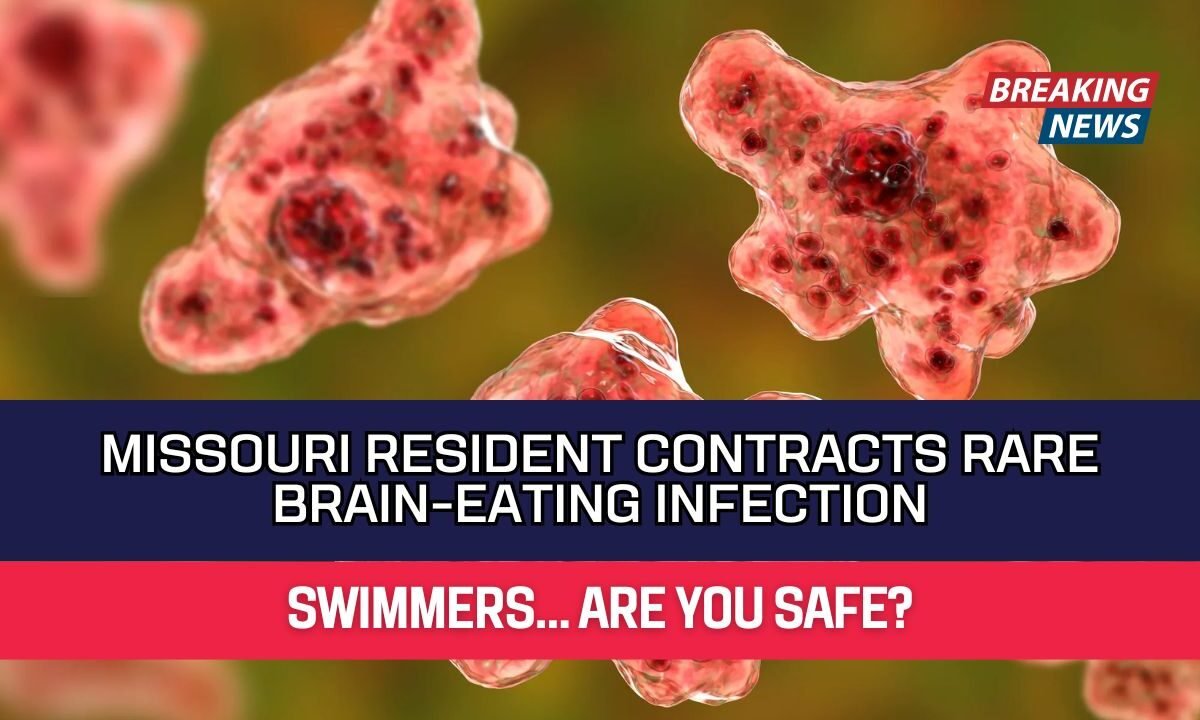A Missouri resident has been diagnosed with a rare and dangerous brain-eating infection caused by Naegleria fowleri. This infection, called Primary Amebic Meningoencephalitis (PAM), is extremely rare but can be deadly.
The case has been confirmed by the Missouri Department of Health and Senior Services (DHSS), and the patient is now being treated in an intensive care unit. While the infection is rare, health officials are warning the public about the possible risks of swimming or doing water sports in warm freshwater bodies during summer.
What is Naegleria Fowleri?
Naegleria fowleri is a microscopic, single-celled ameba that lives naturally in warm freshwater like lakes, rivers, ponds, and hot springs.
- It causes a deadly brain infection known as PAM.
- The ameba enters the body through the nose, usually while swimming, diving, or doing water sports.
- Once inside, it travels to the brain, destroying brain tissue.
From 1962 to 2024, there have been only 167 reported cases in the United States. However, the infection is almost always fatal.
Missouri Case Details
The patient’s exact exposure source is still under investigation, but early reports suggest they may have been water skiing at the Lake of the Ozarks days before becoming ill.
- No other suspected cases are currently being investigated in Missouri.
- The patient is in critical condition in a hospital ICU.
How Rare is This Infection?
DHSS says that fewer than 10 people in the U.S. get PAM each year. Despite its scary nickname, the infection is very rare.
However, it’s important to take precautions because once infected, survival rates are extremely low.
Symptoms to Watch For
Symptoms usually appear 1–12 days after exposure and worsen quickly:
- Severe headache
- Fever
- Nausea and vomiting
- Stiff neck
- Seizures
- Altered mental status
- Hallucinations
If you develop these symptoms after swimming in warm freshwater, seek medical help immediately.
Why Diagnosing PAM is Difficult
Dr. Dana Hawkinson, Medical Director of Infection Prevention at The University of Kansas Health System, says PAM is hard to detect because its early symptoms are general and can be mistaken for other illnesses.
- People may just feel tired or unwell before it suddenly worsens into a central nervous system infection.
Treatment Challenges
Because PAM is so rare, doctors have limited information about effective treatments.
- Current treatment uses a combination of antibacterial, antifungal, and antiparasitic medicines.
- Sadly, even with treatment, the survival rate is very low.
Prevention Tips from Health Experts
To lower your risk of Naegleria fowleri infection, follow these precautions:
| Prevention Step | Details |
|---|---|
| Hold nose shut or use nose clips | Especially when diving, jumping, or underwater in warm freshwater. |
| Keep head above water | Avoid submerging your head in hot springs or untreated warm water. |
| Avoid water activities in high temperatures | Amebas grow faster in warm water. |
| Don’t stir up sediment | Amebas often live in soil at the bottom of lakes and rivers. |
What Experts Say About the Risk
Brain-Eating Infection: Dr. Hawkinson reassures the public that the risk is much lower than other dangers associated with outdoor activities.
Still, taking simple precautions can prevent infection.
About Naegleria Fowleri
- Cannot be spread person-to-person.
- Cannot be caught by drinking contaminated water.
- Enters only through the nose.
- Thrives in warm freshwater, not in saltwater or properly treated swimming pools.
While the Missouri Naegleria fowleri case is alarming, it is a rare occurrence. The infection can be deadly, but awareness and prevention can save lives.
Anyone swimming in warm freshwater should take precautions to stop water from entering their nose and avoid stirring sediment.
If you feel unwell after such activities, get medical attention right away. Early detection is critical for survival and can improve treatment chances for this rare, deadly infection.




